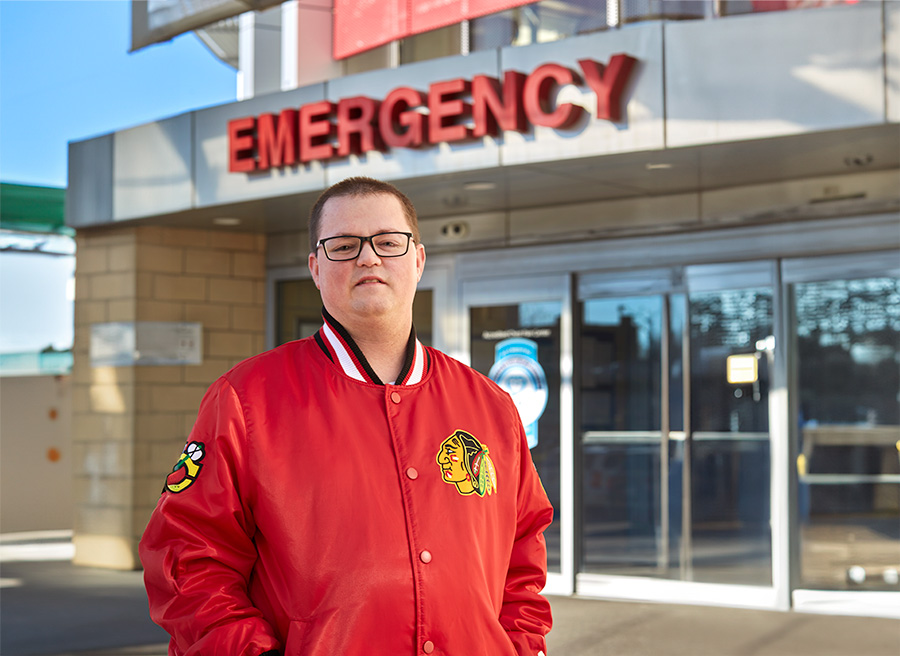
5 minute read
Unexpected Stroke at 34 - How to Recognize Stroke Signs
At just 34, the idea he might be having a stroke never occurred to Bret Davidson.
After all, many associate strokes with older people.
“We thought maybe I was dehydrated,” explained Davidson. “I didn’t think it was a stroke. I was at my son’s hockey tournament in Chicago last February when the rink started spinning. I then started vomiting non-stop for the rest of the day until I was able to go to bed that night. We had driven about halfway home but had to stop at a hotel for the night.”
Davidson, his wife Latasia, and their children Noah, Skylar and Jagger headed home the following day and went right to St. Luke’s ER after returning to Cedar Rapids.
“The woman at the front desk at St. Luke’s ER recognized I was having a stroke right away,” recalled Davidson. “I went immediately to a room and the ER team started working on me.”
“Bret presented with headache, vomiting, and confusion,” said Kurt Chamberlain, MD, St. Luke’s ER physician. “His neurologic exam was concerning, and his eye movements did not line up symmetrically to focus. These issues are an indication for conditions such as a cerebellar stroke, a stroke in the cerebellum, which is used in coordination and balance.”

According to the Centers for Disease Control and Prevention (CDC), every 40 seconds someone in the United States has a stroke. Stroke risk increases with age but can occur at any age. About 38 percent of people hospitalized for a stroke are under age 65. It’s the leading cause of serious long-term disability in the U.S.
Davidson spent three days in intensive care and was moved to St. Luke’s Physical Medicine and Rehabilitation (PM&R) unit to begin his recovery. U.S. News and World Report and Becker’s Hospital Review named UnityPoint Health - St. Luke’s Hospital Physical Medicine and Rehabilitation one of the top rehab hospitals in Iowa.
“When he first came to our rehab unit, Bret was not able to walk on his own,” recalled Katrina Mahoney, St. Luke’s PM&R senior physical therapist. “Bret had some difficulty talking but you could easily tell he wanted to return to his job and get back to being a dad.”

“I didn’t talk well at first,” shared Davidson. “You couldn’t make out what I was trying to say a lot of the time. And I had to relearn how to walk because my balance was off. My fine motor skills were not present. I couldn’t use my hands well at first.”
How to Recover from a Stroke
At St. Luke’s, Davidson participated in daily, physical, occupational and speech therapy for the next two weeks.
“We ended up doing some fun things in therapy,” explained Mahoney. “Before his stroke he was ice skating and playing hockey with his kids – so we were able to simulate a little of that in our rehabilitation gym. We’d use glide boards and other similar items to work on his balance. He made so much progress.”
After Davidson was released from St. Luke’s PM&R inpatient rehab program, he returned for outpatient therapy where the team continued their collaborative work. Davidson spent the next five months working on regaining what the stroke took away from him.
“When we discharged Bret from therapy in July, his balance scored within the normal range for his age,” shared Mahoney. “He was doing jumping jacks, push-ups, climbing ladders and a lot of hard work. We were working on getting him back to his supervisor position at a production facility. He was able to return to work that same month he completed outpatient therapy at St. Luke’s.”
A Closer Look at What May Cause a Stroke
Davidson had a patent foramen ovale closure (PFO) procedure last summer following his stroke. A PFO is a hole in the heart, which typically closes after birth. The hole is an opening between the upper heart chambers. It usually doesn’t cause complications but sometimes small blood clots travel elsewhere in the body, likely the cause of Davidson's stroke.
“The important thing to remember is that not all strokes occur in elderly patients with predisposing factors such as hypertension, high cholesterol and diabetes,” Dr. Chamberlain said. “They can also occur as a result of an artery dissection or tear, a hemorrhage, or other factors. The symptoms aren’t always obvious such as one-sided weakness or speech difficulty. The important thing is to get to the ER if someone is showing some of the signs of a stroke just to be sure. Look for things like, is their balance off, are they having vision problems, does one side of their face droop, is one arm weak or numb or is their speech slurred? If they have any of these symptoms call 911 immediately.”
“St. Luke’s was a big help in getting me back to work and back to my life,” shared Davidson. “I am working again, driving on my own and I was told to take a year off from recreational hockey, but I’d like to get back to it again next fall.”
Many strokes can be prevented by living a healthy life and working with your healthcare provider, to reduce health issues, which can raise stroke risk. If you do not have a primary care provider, find one at www.unitypoint.org/providers






